小学英语第册教案北师大版
新北师大版英语三年级上册全册教案
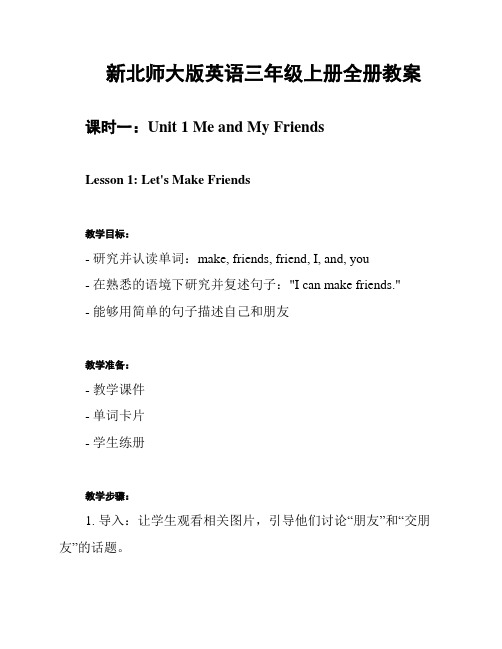
新北师大版英语三年级上册全册教案课时一:Unit 1 Me and My FriendsLesson 1: Let's Make Friends教学目标:- 研究并认读单词:make, friends, friend, I, and, you- 在熟悉的语境下研究并复述句子:"I can make friends."- 能够用简单的句子描述自己和朋友教学准备:- 教学课件- 单词卡片- 学生练册教学步骤:1. 导入:让学生观看相关图片,引导他们讨论“朋友”和“交朋友”的话题。
2. 通过展示单词卡片的方式,教授新单词:make, friends, friend, I, and, you。
帮助学生正确发音并理解词义。
3. 在课件中展示简单的句子:“I can make friends.”,并纠正学生的发音。
利用肢体语言和示范,帮助学生理解句子的意思。
4. 师生互动练句子,并逐渐引导学生能够用正确的语音和语调表达句子。
5. 学生个别练和小组活动:让学生用自己的话描述自己和朋友。
鼓励学生尽量运用所学的单词和句子。
6. 小结:总结本课所学内容,鼓励学生用“朋友”和“交朋友”为话题展开讨论。
课堂作业:1. 完成练册上与本课相关的练。
2. 练和复述本节课所学内容。
课时二:Unit 1 Me and My FriendsLesson 2: Let's Sing教学目标:- 研究并唱歌谣:Make Friends教学准备:- 教学课件- 音乐播放器教学步骤:1. 导入:回顾上节课所学内容,引出本节课要研究的歌谣。
2. 播放演唱Make Friends歌谣的音乐,让学生先跟随音乐节奏拍手和跺脚。
鼓励学生积极参与。
3. 引导学生跟随音乐歌唱,帮助他们熟悉歌曲中的重要单词和短语。
4. 教师带领学生逐句学唱整首歌曲,并强调正确发音和语调。
5. 学生个别练和小组活动:学生分组进行唱歌比赛,评选最好的组合。
北师大版小学英语第一册全册教案
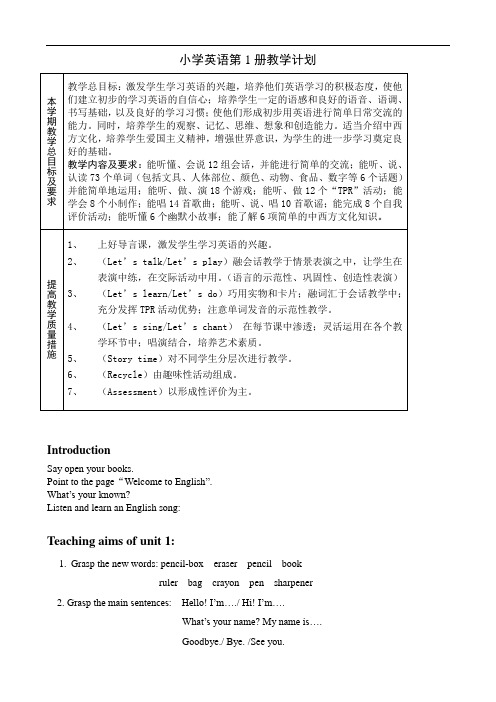
小学英语第1册教学计划IntroductionSay open your books.Point to the page“Welcome to English”.What’s your known?Listen and learn an English song:Teaching aims of unit 1:1.Grasp the new words: pencil-box eraser pencil bookruler bag crayon pen sharpener 2. Grasp the main sentences: Hello! I’m…./ Hi! I’m….What’s your name? My name is….Goodbye./ Bye. /See you.And get the students to use these sentences to communicate with each other.3. Grasp the TPR activities in the part of “Let’s do”.Try to say these phrases and respond the actions correctly.4. Learn to sing two songs: Hello! Happy Teachers’ Day!5. Learn to the part of “Let’s chant”. Understand the meaning of the chant and try to grasp the patterns “I have….” and “ Me too”.6. Try making a name card.7. Enable the students to understand the story in the part of “Story time”. Try to read and retell the story.Teaching arrangement:Lesson 1: A: Let’s talk Let’s playLesson 2: A: Let’s learn Let’s doLesson 3: A: Let’s make C: Culture Let’s singLesso n 4: B: Let’s talk Let’s playLesson 5: B: Let’s learn Let’s do Let’s singLesson 6: B: Let’s check Let’s chant C: Story timeLesson 1Teaching aims:1.Try to make a self-introduction with the pattern “ I’m…”.2.Learn to use Hello, Hi, Goodbye and Bye to communicate with others.3.Learn to sing a song: HelloPreparation: Recorder and tape.Steps:(1). Warm-upListen to the song: Hello.(2). Presentationa.Teacher shows and introduces a new friend: a bear. “Hello. I’m Teddy. Y ou can call meTeddy Bear. ” Goes to the pupils seat and greets to them, shake the hands.b.Ask pupils to practice this dialogue and later ask some pairs come to the front to act.(3). Presentationa. Listen to the song: Hello and pass a toy. If a child get the toy when the song is stopping,he(she) say: Hello(Hi)! I’m…b. Some children who haven’t got the toy stand up and introduce himself(herself): Hello(Hi)!I’m…(4). PracticeTeacher change the voice and make up like wear a pair of glasses. Then teacher goes with Teddy Bear into the classroom, greets to one pupil with the dialogue above, and at last adds up a sentence: Goodbye! Practice and act the conversation in groups. Then asks somegroups to act it.(5). Add-activitiesa. Listen and read after the tape, imitate the tape.b. Find a group of friends to make the conversation.Lesson 2Teaching aims:1. Grasp the new words: pencil, crayon, eraser, ruler, pen and phrases: a pencil, a crayon, aneraser, a ruler, a pen.2. Respond the TPR activities “Show me your…”quickly and correctly. *Try to use this phrase. *3. Learn to say“I have a/an…” Substitute the pattern with five new words.Preparation:a. A Teddy Bearb. Tape and recorderc. A pencil-box with a pen, a pencil, a ruler, an eraser, a crayon.Steps:(1). Warm-up/Reviewa. Listen to the song: Hello.b. Greets to pupils with: Hello/Hi. And hug them or shake hands.c. Make a conversation like last lesson.(2). Presentationa. Show a pencil-box. Let children guess : What is it in the pencil-box?(in Chinese) Then introduces to everybody like: Y es! Pencil. I have a pencil.b. Use this form, let pupils guess and learn the words: pencil, pen, ruler, eraser, crayon.(3). Practicea. Game:Say what is it in your pencil-box.-- I have a pen.b. Teddy Bear asks: What’s this in English? Pupils say: eraser. Do as this.(4). Let’s doa. Listen to the tape and teacher do it first t show the means.b. Asks pupils to follow teacher to do it and say if they can.c. Do it after tape like:-- Show me your pencil. -- My pencil.(5). AssessmentPlay a bingo game with those words: crayon, pencil, eraser, …Lesson 3Teaching aims:1.Try to make a name card.2.Enable the students to know some knowledge about Teachers’ Day and encourage them to sayHappy Teachers’ Day to other teachers.3. Learn to sing a song: Happy Teachers’ Day*4. Make a teacher’s card and present the teacher you like.Preparation:a. Tape and recorderb. A name cardSteps:(1). Warm-up/Reviewa.Listen to the song: Happy Teachers’ Dayb.Do it: Show me your…(2). Practicea. Shows pupils a name card and asks pupils how can we make the name card.b. Told pupils how can they make the name card in English.c.Pupils make it by themselves and say how does he(she) make it in English.(3). Enable the students to know some knowledge about Teachers’ Day: When is Teachers’Day and encourage them to say Happy Teachers’ Day to other teache rs.*Make a teacher’s card and present the teacher you like.(4). Let’s sing: Happy Teachers’ DayListen and sing the song.Lesson 4Teaching aims:1. Get the students to grasp the sentences: What’s your name? My name is….2. Learn to use the phrase See you to express goodbye and try to use the word: Welcome.3.Practice and make dialogues about self-introduction.Preparation:Tape and recorderSteps:(1). Warm-up/ Reviewa.Sing the song: Happy Teachers’ Dayb.Make a greeting to each other.(2). Presentationa. Listen to the tape and then asks them what they heard.b. Point to the name in a Pupil’s Book so that lets pupils know what’s mean of this sentence.c. Asks pupils to practice this dialogue and later ask some pairs come to the front to act.(3). PracticeMake a conversation, connect the texts in part A.(4). Main pictureBack to the main picture, point and find what they are talking. Then hand out the sortition paper to pupils. Pupils get it and find what picture it is. And them imitate those visualizes, make a conversation according to the main picture: Hello! I’m Sarah. What’s your name?My name’s Chen Jie. Goodbye! Bye, Miss White!(5). Add-activitiesListen and read after tape and make the dialogue.Lesson 5Teaching aims:1.Grasp the new words: bag, pencil-case, book, sharpener, school and the phrases a bag, apencil-case, a book, a sharpener.2.Respond the TPR activities quickly and correctly.*Try to say “open/ close/ carry/ your …”and “go to school”.*3.Substitute the pattern “ I have a…”. Learn to say and use the sentence “Me too!”.4.Learn to sing a song: HelloPreparation:a.Tape and recorderb. A pencil-case, a bag, a book, a sharpenerSteps:(1). Warm-up/Reviewa.Sing a song: Happy Teachers’ Dayb.Do it (Part A – Lesson 2)(2). Presentationa. Let children guess: What is it?Then introduces to everybody like: Yes! Bag. I have a bag.b. Use this form, let pupils guess and learn the words: bag, book, pencil-case, sharpener,school.(3). Practicea. Asks: What’s this in English? Pupils say: sharpener. Do as this.b. Game:Say what is it?-- I have a bag. --Me too!(4). Let’s doa. Listen to the tape and teacher do it first t show the means.b. Asks pupils to follow teacher to do it and say if they can.c. Guess and learn the word: school.(5). Learn to sing a song: Hello(6). AssessmentPlay a bingo game with those words: crayon, pencil, eraser, pen, ruler, bag, book, pencil-case, sharpener.Lesson 6Teaching aims:1. Exercise in the part of “Let’s check”.2. Learn to say the part of “Let’s chant”. Perform it and replace it in the proper place.3. Listen and watch a story about Zip & Zoom. Try to understand the meaning and try to retell thestory.4.Review the new songs in the unit.Preparation:a.Tape and recorderb.Some pictures for sortitionSteps:(1). Warm-upa. Sing a song: Hellob. Greet to each other.c. Do it. (Part B – Lesson 2)(2). Practicea. Let’s chant.Listen first and understand the means. Then chant in pairs and act it.Chant it together.b. Let’s check.Listen the tape and do it.(3). Story timea. Do as me: Teacher do an action and pupils do the same and say it.b. When pupils finish saying, Teddy Bear and squirrel go into the classroom and act that story.Those two pupils were teached yesterday by teacher.c. Asks everyone to talking like the story showing.d. Asks two to practice the dialogue. And then act it.(4). Let’s sing: HelloTeaching aims of unit 2:1.Grasp the new words: head face nose mouth eye eararm hand finger leg foot body2. Grasp the main sentences: Good morning. Good afternoon.This is …Nice to meet you.And get the students to use these sentences to communicate with each other.3. Grasp the TPR activities in the part of “Let’s do”.Try to say these phrases and respond the actions correctly.4. Learn to sing two songs: Teddy Bear. Head, Shoulders, Knees and Toes.5. Learn to the part of “Let’s chant”. Understand the meaning of the chant and try to grasp the patterns “Where is your…?” and “ Here it is.”6. Try drawing a face.7. Enab le the students to understand the story in the part of “Story time”. Try to read and retell the story.Teaching arrangement:Lesson 1: A: Let’s talk Let’s playLesson 2: A: Let’s learn Let’s doLesson 3: A: Let’s make Let’s singLesson 4: B: Let’s talk Let’s play CultureLesson 5: B: Let’s learn Let’s do Let’s singLesson 6: B: Let’s check Let’s chant C: Story timeTeaching aims :1.Listen, speak, and read the words head, face, nose, mouth, eye, ear, arm, hand, finger, leg, foot,body. And use those words to describe the part of the body, e.g. Look at me. This is my head. 2.Listen and speak the words good, morning, this, nice, meet, let’s, go, OK, to, mom, afternoon,too. And use those words to greet to others. E.G. Hello. Good morning. This is John.3.Enable pupils to understand and communicate with some dialogue:-- Good morning. -- Where’s your mouth?Hello. This is John. Here it is.Nice to meet you. Where’s your hand?Let’s go to school. Here it is.4.Enable pupils to understand and do some instructions. E.G. Touch your head. Or : Clap yourhands.5.Through the “chant” let pupils master the new words, and create the new chant. Interests themwith the songs.6.Enable them to read some short story with the pictures and later act it or extend the story. Lesson 1Teaching aims:1.Learn to use Good morning, Hello, Hi, This is…, Nice to meet you to communicate withothers.2.Learn to sing a song: Teddy Bear.Preparation:a. Prepare a toy bear.b. Recorder and tape.Steps:(1). Warm-up/Reviewa. Listen to the song: Hello.b. Greets to pupils with sentences they’ve learned.c.Practice a sentence: I have a…(2). Presentationa. Teacher shows a friend: a bear. “Hello. I’m Teddy. Good morning.” Goes to the pupils seat andgreets to them, shake the hands.b. Greets to one pupil and at last say: Nice to meet you.c. Asks pupils to practice this dialogue and later ask some pairs come to the front to act.(3). Presentationa. Teddy Bear goes near a pupil and greet to him or her. Then asks: Excuse me. What’s his/hername? Help him or her to say: This is…Then faces to him/her and say: Nice to meet you.b. Do twice and ask pupils practise in groups.c. Asks some groups to act it.(4). Practicea. Teacher changes the voice and make up like wear a pair of glasses. Then teacher goes withTeddy Bear into the classroom, greets to one pupil with the dialogue above, and at last adds upa sentence: Let’s go to school! Give Teddy Bear a very smal l bag to show the means.b. Practise and act the conversation in groups. Then asks some groups to act it.(5). Add-activitiesa. Listen and read after the tape, imitate the tape.b. Find a group of friends to make the conversation.Lesson 2Teaching aims:1. Grasp the new words: head, eye, face, ear, nose, mouth.2. Respond the TPR activities “Touch your …”quickly and correctly. *Try to use this phrase.Preparation:a.Picture of Teddy Bearb.Pictures of body of Teddy Bear in a bagc. Tape and recorderSteps:(1). Warm-up/Reviewa. Sing a song : Hello!b. Greets to pupils with: Nice to meet you. And hug them or shake hands.c. Make a conversation like last lesson’s.(2). Presentationa. Shows the bear. And then dubs for the bear to greet to pupils: Hi. Good morning. Nice tomeet you again. Or Nice to see you again.b. Greets to the pupils and practise like that. Then introduces to everybody like : Look at me.This is my head.c. Use this form, let pupils ask the learn the words: head, ear, eye, nose, face, mouth.(3). Practicea. Game:Guess what is it in the bag.-- What is it?-- A nose?b. Teddy Bear say: What’s this in English? Pupils say: This is your eye. Do as this.(4). Let’s doa. Listen to the tape and teacher do it first to show the means.b. Asks pupils to follow teacher to do it and say if they can.c. Correct the pronunciation of the word : touch.d. Do it after tape like:--- Touch your head. --- My head.(5). Add-activitiesa. Listen and read after the tape, do the chant again.b. Do a puppetLesson 3Teaching aims:1. Learn to sing a song: Teddy Bear.2. Try drawing a face.Preparation:a. Tape and recorderb. A picture of the big empty facec. Decorations on head (bear and squirrel)Steps:(1). Warm-up/Reviewa. Listen to a song: Teddy Bearb. Do it: Touch your …(2). Let’s singa. Listen to the song: Teddy Bear. And teacher do it to show the means of that song.b. Try to sing(3). Let’s drawa. Asks two pupils come to the board to draw and others draw on the paper. Draw the differentparts of the body but in order. Then put it under the projection to show.b. Game: Draws a big empty face on the blackboard, and asks some pupils to come anddraw in order without looking.(4). AssessmentSing the song again(change it).Lesson 4Teaching aims:1.Learn to use Good afternoon, Hello, Hi, This is…, Nice to meet you to communicate withothers.2.Practice and make dialogues .3. Enable the students to know some knowledge about Halloween.Preparation:Tape and recorderSteps:(1). Warm-upa. Listen and sing the song: Teddy Bear.b. Make a greeting to each other.c. Let’s do: Touch your…(2). Culturea. Listen to the tape (<SK>), in the tape are the sound of ghost, spirits, pumpkin, switch, etc.After listening, asks pupils to guess or imitate the things. Then tall them where they are appearing and when.b. Say something about the “Halloween”.(3). Presentationa. Listen to the tape and then asks them what they heard.b. Show sentences: Good afternoon. Then teacher make a strange look, asks What’s mean ofthis sentence.(4). Practicea. Make the dialogue with time.b. Make a conversation, connect the texts in part A.(5). Main pictureBack to the main picture, point and find what they are talking. Then hand out the sortition paper to pupils. Pupils get it and find what picture it is. And them imitate those visualizes, make a conversation according to the main picture: Happy Halloween! Hello. Good evening. I’m spirit and this is ghost. (outcry) Look. This is my big eye. Nice to meet you. (6). Add-activitiesListen and read after tape and make the dialogue.Lesson 5Teaching aims:1. Grasp the new words: arm hand finger leg foot body2. Respond the TPR activities quickly and correctly.*Try to say “clap/ snap/ wave/cross/shake/stamp your…”.3. Learn to sing a song: Head, Shoulders, Knees and Toes.Preparation:a. Tape and recorder*b. A toy personSteps:(1). Warm-up/Reviewa. Sing a song: Teddy Bearb. Do it (Part A – Lesson 2)(2). Presentationa.Shows a toy person, points some words they know to say.b.Shows some parts of body they don’t know and read these words without voice, just asksthem to guess.c.Learn those words, and teacher says one part, they point or raise it/them.(3). Practisea. Let’s do:Listen to the tape and teacher do it first to show the means.Asks pupils to follow teacher to do it and say if they can.b. Add-activities.Add up the words: left &right Practise again like: your left hand …….c. Dancing with instructions: Y our hands, left, left, right, right, …….(4). Add-activitiesListen and read after the tape and dance.(5). Let’s singa. Listen to the song: Head, Shoulders, Knees and Toes. And teacher do it to show the means ofthat song.b. Try to singLesson 6Teaching aims:1. Exe rcise in the part of “Let’s check”.2. Learn to say the part of “Let’s chant”. Perform it and replace it in the proper place.3. Listen and watch a story about Zip & Zoom. Try to understand the meaning and try to retell thestory.4.Review the new songs in the unit.Preparation:a. Tape and recorder*b. Some pictures for sortitionSteps:(1). Warm-upa. Dancing for revise the parts of body.b. Do it. (Part B – Lesson 2)c. Greet to each other.(2). Practisea. Let’s chant.Listen first and then asks and answer. Do it last.b. Let’s check.Listen the tape and do it.(4). Story timea. Do as me: Teacher do an action and pupils do the same and say it.b. When pupils finish saying, Teddy Bear and squirrel go into the classroom and act that story.Those two pupils were teached yesterday by teacher.c. Asks everyone to take out a piece of paper and make an animal they like with talking like thestory showing.d. Asks two to practice the dialogue. And then act it.Teaching aims of unit 3:1.Grasp the new words: red yellow green blue purplewhite black orange pink brown2. Grasp the main sentences: How are you?Fine, thank you. /I’m fine. / Very well, thanks.And get the students to use these sentences to communicate with each other.3. Grasp the TPR activities in the part of “Let’s do”.Try to say these phrases and respond the actions correctly.4. Learn to sing two songs: Who Is Wearing Y ellow Today? Colour Song.5. Learn to the part of “Let’s chant”. Understand the meaning of the chant and try to grasp the patterns.6. Try painting a face.7. Enable the students to understand the story in the part of “Story time”. Try to read and retell the story.Teaching arrangement:Lesson 1: A: Let’s talk Let’s playLesson 2: A: Let’s learn Let’s doLesson 3: A: Let’s make Let’s sing C: Story timeLesson 4: B: Let’s talk Let’s play CultureLesson 5: B: Let’s learn Let’s do Let’s singLesson 6: B: Let’s check Let’s chantLesson 1Teaching aims:1.Learn to use: Good morning, How are you, Fine, thank you, This is…, Nice to meet you tocommunicate with others.2.Learn to sing a song: Who Is Wearing Y ellow Today?Preparation:a. Prepare a toy bear.b. Recorder and tape.Steps:(1). Warm-up/Reviewa. Listen to the song: Head, Shoulders, Knees and Toes.b. Greets to pupils with sentences they’ve learned.(2). Presentationa. Listen to the tape and look at the pictures.b. Guess the dialogue’s mean.c. Learn to use: How are you, Fine, thank you to communicate with others.(3). Let’s playUse sentences: Good morning/ Good afternoon. How are you? Fine, thank you.Greeting each other with pairs.(4). Presentationa. Listen to the tape again.b. Look at the pictures and read after the tape.c. Practise in groups.d. Asks some groups to act it.(5). Add-activitiesa. Listen and read after the tape, imitate the tape.b. Find a group of friends to make the conversation.(6). Listen to the song: Who Is Wearing Y ellow Today?Lesson 2Teaching aims:1. Grasp the new words: blue, green, yellow, red, purple.2. Respond the TPR activities “Show me your …”quickly and correctly. *Try to use this phrase.Preparation:Tape and recorderSteps:(1). Warm-up/Reviewa. Listen to the song: Who Is Wearing Y ellow Today?b. Greets to pupils with: Nice to meet you. And hug them or shake hands.c. Make a conversation like last lesson’s.(2). Presentationa. Shows a pictureb. Introduces to everybody lik e: Look at the picture. What colour is it? It’s blue.c. Use this form, let pupils ask the learn the words: blue, green, yellow, red, purple.(3). PracticePlay a game: What colour is it?No looking and guess what colour is the crayon?(4). Let’s doa. Listen to the tape.b. Asks pupils to follow teacher to do it if they can.c. Do it and say if they can.d. Correct the pronunciation.d. Do it like:---Show me your red crayon. ---Here it is!(5). Add-activitiesListen and read after the tape, do the chant again.Lesson 3Teaching aims:1. Learn to sing a song: Who Is Wearing Y ellow Today?2. Try painting.3. Listen and watch a story about Zip & Zoom. Try to understand the meaning and try to retell thestory.Preparation:Tape and recorderSteps:(1). Warm-up/Reviewa. Listen to a song: Who Is Wearing Y ellow Today?b. Do it: Show me your …(2). Let’s singa. Listen to the song: Who Is Wearing Y ellow Today? And look the picture under the song toguess the mean of the song.b. Try to sing(3). Let’s painta. Asks pupils paint the different parts of the body but in order. Then put it under the projectionto show.(4). Assessmenta. Play a bingo game with those words: crayon, eraser, pencil-case, sharpener, red, blue,green, yellow, purple.b. Sing the song again(change it).(5). Story timea. Do as me: Teacher do an action and pupils do the same and say it.b. When pupils finish saying, Teddy Bear and squirrel go into the classroom and act that story.Those two pupils were teached yesterday by teacher.c. Look at the pictures and listen to the tape.d. Asks two to practise the dialogue. And then act it.Lesson 4Teaching aims:1.Learn to use Hello, Hi, How are you, Fine, I’m fine, Thanks, Thank you and so on tocommunicate with others.2.Practice and make dialogues .3. Enable the students to know some knowledge about flags.Preparation:1. Tape and recorder2. Pictures of flagsSteps:(1). Warm-upa. Listen and sing the song: Who Is Wearing Y ellow Today?b. Make a greeting to each other.(2). Presentationa. Make a greeting to a pupil and lead him to ask me the question how are you? The answer isI’m fine, thanks.b. Asks pupils that reading after me. Tells pupils the mean of thanks.c. Learn the sentences: Let’s paint! Great!d. Listen to the tape and look at the pictures. Read after the tape.(3). Practicea. Let’s play and learn to use very well.b. Make the dialogue with time.c. Make a conversation, connect the texts in part A.(4). CultureLook at some pictures of flags. Enable the students to know some knowledge about these flags. Try to say what color is the flag.Lesson 5Teaching aims:1. Grasp the new words: brown, black, white, pink, orange.2. Respond the TPR activities “Black, black. Stand up, and so on ” quickly and correctly. *Try touse this phrase.Preparation:1. Tape and recorder2. Some word’s cardsSteps:(1). Warm-up/Reviewa. Listen to the song: Color Song.b. Greets to pupils with: How are you?c. Make a conversation like last lesson.(2). Presentationa. Shows a pictureb. Look at the picture. What color is it? It’s blue. I like blue.Revision the s entence: I like … Lead to the new words: orange.c. Use this form, let pupils learn the words: orange, pink, white, black, brown.(3). Practicea. Play a game: What color is it?No looking and guess what color is the crayon?b. Listen, read, and point.(4). Let’s doa. Listen to the tape.b. Asks pupils to follow teacher to do it if they can.c. Do it and say if they can.d. Correct the pronunciation.d. Do it like:---Show me your white crayon. ---Here it is!(5). Add-activitiesListen and read after the tape, do the chant again.Lesson 6Teaching aims:1. Exercise in the part of “Let’s check”.2. Learn to say the part of “Let’s chant”. Perform it and replace it in the proper place.3.Review the new songs in the unit.Preparation:a. Tape and recorder*b. Some color ballSteps:(1). Warm-upa. Sing the song: Color Song.b. Do it. (Part B – Lesson 2)c. Greet to each other.(2). Practicea. Let’s chant.Shows a pink ball and says: This is a b all. It’s a pink ball.Use this form, let pupils to learn the phrases.Listen first and then chant it to the tape.b. Let’s check.Listen the tape and do it.Teaching aims of recycle 1:1.复习第1—3单元所学的会话,要求学生能在实际的情景中运用。
最新北师大版小学英语四年级上册全册教案

北京师范大学出版社小学英语四年级教案对新课标理解:现在的社会是向着全球化,社会化发展的英语逐渐的成为我们生活中不可缺少的一部分,越来越被人重视,作为教育发展的重要环节,作为迎接未来世界的一把钥匙。
新课标强调课程应从学生的学习兴趣、生活体验和认知水平出, 倡导学生体验、实践、参与、合作与交流的学习方式和任务型的必学途径,发展学生的综合语言运用能力,使语言学习的过程成为学生形成积极的情感态度,主动思维和大胆实践,提高跨文化意识和形成自主学习能力的过程。
做到这些要求,首先需要的就是学生浓厚的对英语学习的兴趣,那怎么样培养学生学习兴趣就成了一个基础话题,这一问题要面向全体学生,特别是要关注学生的个别差异引起的情感问题。
帮助学生建立成就感和自信心。
在教学中注意创设能引导学生主动参与的教学环境,激发学生的学习积极性。
使每个学生都能得到充分的发展。
在这一过程中教学模式的转变起到了一定的作用,一定要从以老师为中心的教学模式身以学生为中心的教学模式转变。
强调学生的参与和体验,强调采用多种形式的教学活动。
比如可以利用我们学校已有的良好电教资源,听原版录音带练习发音,也可以利用网络找一些贴近课堂学习的情境对话或小动画,以更直接的方式引导学生学习英语,对英语产生浓厚的兴趣。
总的来说,新课标对发展学生自我主观能动性起到了很积极的作用。
素质教育在其中深有体现。
并且由升学教育向终身教育的转变等等都是很好的突破。
在这一新课标的指导下,希望在英语教学中可以达到更好的效果。
Teaching Aims:知识技能:1、Listening:充分利用学校的电教资源,在发展学生自主学习的基调上,让学生可以接触到更多、更直观的学习方式,比如听录音,看小动画等等。
掌握部分日常用语,如:能听懂询问名子的问及回答,或问是谁的语句。
辨别词中的字母的不同读法。
2、Speaking:根据本册书的教学要求,作为基本的主导方向,指导学生在教师为学生设计的教学情境中,能够正确运用问名子,问是谁,问是什么等等的语句,并能对所提问的句子做出适当的回答。
北师大版小学英语四年级上册全册教案
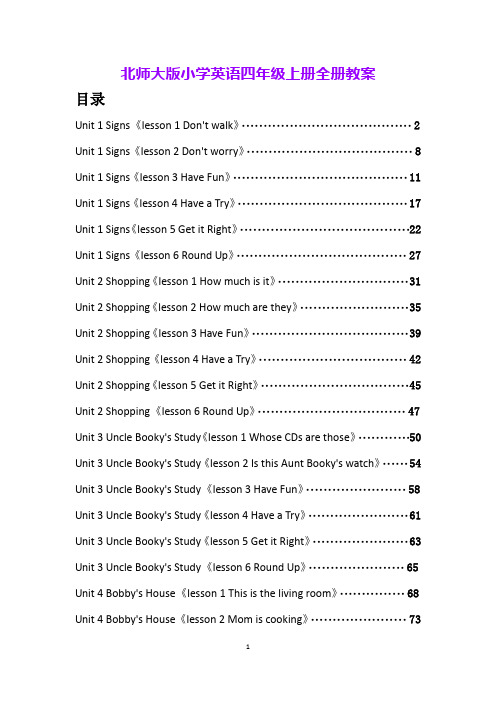
北师大版小学英语四年级上册全册教案目录Unit 1 Signs《lesson 1 Don't walk》 (2)Unit 1 Signs《lesson 2 Don't worry》 (8)Unit 1 Signs《lesson 3 Have Fun》 (11)Unit 1 Signs《lesson 4 Have a Try》 (17)Unit 1 Signs《lesson 5 Get it Right》 (22)Unit 1 Signs《lesson 6 Round Up》 (27)Unit 2 Shopping《lesson 1 How much is it》 (31)Unit 2 Shopping《lesson 2 How much are they》 (35)Unit 2 Shopping《lesson 3 Have Fun》 (39)Unit 2 Shopping《lesson 4 Have a Try》 (42)Unit 2 Shopping《lesson 5 Get it Right》 (45)Unit 2 Shopping《lesson 6 Round Up》 (47)Unit 3 Uncle Booky's Study《lesson 1 Whose CDs are those》 (50)Unit 3 Uncle Booky's Study《lesson 2 Is this Aunt Booky's watch》 (54)Unit 3 Uncle Booky's Study《lesson 3 Have Fun》 (58)Unit 3 Uncle Booky's Study《lesson 4 Have a Try》 (61)Unit 3 Uncle Booky's Study《lesson 5 Get it Right》 (63)Unit 3 Uncle Booky's Study《lesson 6 Round Up》 (65)Unit 4 Bobby's House《lesson 1 This is the living room》 (68)Unit 4 Bobby's House《lesson 2 Mom is cooking》 (73)Unit 4 Bobby's House《lesson 3 Have Fun》 (77)Unit 4 Bobby's House《lesson 4 Have a Try》 (80)Unit 4 Bobby's House《lesson 5 Get it Right》 (83)Unit 4 Bobby's House《lesson 6 Round Up》 (89)Unit 5 At school《lesson 1 What subjects do you have》 (91)Unit 5 At school《lesson 2 This is our classroom》 (95)Unit 5 At school《lesson 3 Have Fun》 (102)Unit 5 At school《lesson 4 Have a Try》 (105)Unit 5 At school《lesson 5 Get it Right》 (108)Unit 5 At school《lesson 6 Round Up》 (115)Unit 6 《Review》 (117)Unit 1 Signs《lesson 1 Don't walk》1教学目标1、听懂、会说Hello./Hi . Goodbye./Bye-Bye. I'm ...。
北师大版小学英语二年级上册教案 全册
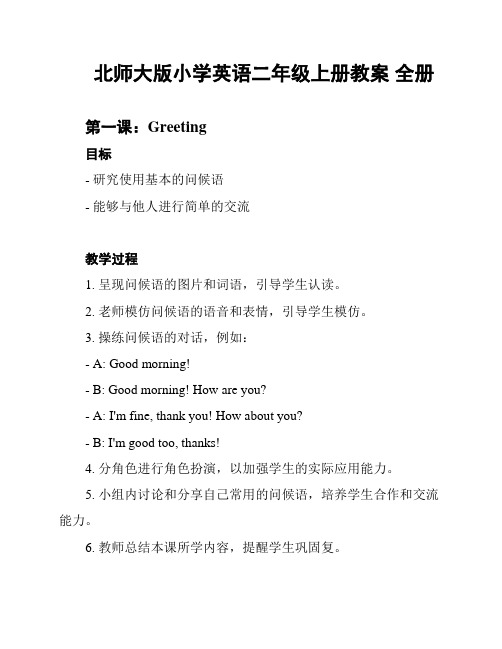
北师大版小学英语二年级上册教案全册第一课:Greeting目标- 研究使用基本的问候语- 能够与他人进行简单的交流教学过程1. 呈现问候语的图片和词语,引导学生认读。
2. 老师模仿问候语的语音和表情,引导学生模仿。
3. 操练问候语的对话,例如:- A: Good morning!- B: Good morning! How are you?- A: I'm fine, thank you! How about you?- B: I'm good too, thanks!4. 分角色进行角色扮演,以加强学生的实际应用能力。
5. 小组内讨论和分享自己常用的问候语,培养学生合作和交流能力。
6. 教师总结本课所学内容,提醒学生巩固复。
拓展活动- 学生可编写问候语的对话,并与其他小组进行交流。
- 在课堂上进行问候语的表演或比赛,以激发学生的兴趣和参与度。
第二课:Colors目标- 研究基本的颜色词汇- 能够用基本的句型描述物品的颜色教学过程1. 呈现不同颜色的图片,引导学生观察并说出颜色。
2. 研究颜色词汇,并进行发音训练。
3. 引导学生用句型"This is a [color] [object]." 描述物品的颜色。
4. 进行游戏,例如:“Teacher says”,老师用指令引导学生说出正确的句子。
5. 老师出示物品,学生用适当的颜色进行描述,例如:“This isa blue pen.”6. 教师总结本课所学内容,提醒学生巩固复。
拓展活动- 学生制作个人颜色卡片,通过游戏来识别和配对颜色。
- 学生可以在班级中进行颜色展示,用英语描述展示物品的颜色。
...(继续完整的教案内容)。
北师大版小学英语教案
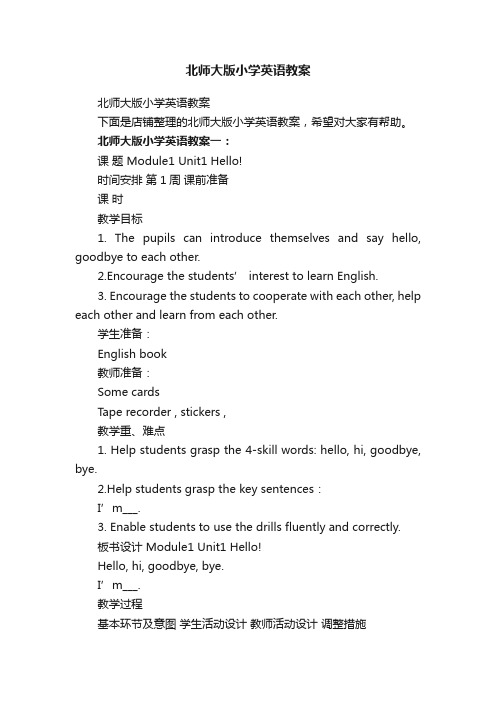
北师大版小学英语教案北师大版小学英语教案下面是店铺整理的北师大版小学英语教案,希望对大家有帮助。
北师大版小学英语教案一:课题 Module1 Unit1 Hello!时间安排第1周课前准备课时教学目标1. The pupils can introduce themselves and say hello, goodbye to each other.2.Encourage the students’ interest to learn English.3. Encourage the students to cooperate with each other, help each other and learn from each other.学生准备:English book教师准备:Some cardsTape recorder , stickers ,教学重、难点1. Help students grasp the 4-skill words: hello, hi, goodbye, bye.2.Help students grasp the key sentences:I’m___.3. Enable students to use the drills fluently and correctly.板书设计 Module1 Unit1 Hello!Hello, hi, goodbye, bye.I’m___.教学过程基本环节及意图学生活动设计教师活动设计调整措施一、Warming up and Revision二、Leading-in三、Listening & Reading Activities一、1 .Greetings.2. Say in Chinese.二、1. Look and listen.2. Learn and say the words with each other.3. Listen and find who they are.三、1.Open their books, listen to the tape carefully.2.Answer the question:They are Daming,,Lingling,Sam and Amy.一、Warming up and Revision1. Greetings.2. Talk about why we will study English.二、Leading-in1. Introduce myself to the students.2. Say” hello, hi, I’m___, goodbye, bye” to thestudents.3. Introduce there are 4 new friends will cometo our class.三、Listening & Reading Activities1. Ask the students to open their books,turn topage 2,then play the tape.教学过程基本环节及意图学生活动设计教师活动设计调整措施四、1. Further Development2.Homework3. Listen and point carefully.4. The students listen and repeat. Then drill these words and sentences in different ways.5. Each group will act one person, then change.四、1. The students practice in small groups.2. Act it out. (The best group will get a prize.)3. The students finish it in the class.4. Say some sentences about this video.五、1.Finish this homework.2. Ask some questions: Who are they?3. Let the students listen and point the text and then check the students.4. Let the students listen, point and repeat the text.5. Play the tape again; let the students read the text in 4 big groups.四、Further Development1.Give them2 minutes to practice the text in small groups2. Check the students.3.Activity book4. Play a video about greeting.Homework1. Listen to the tape to review this unit.2. Say hello and hi, goodbye and bye, introduce yourself to your parents and other people.•共3页:•上一页•1•2•3 •下一页。
最新北师大版英语小学三年级上册全册优质教案
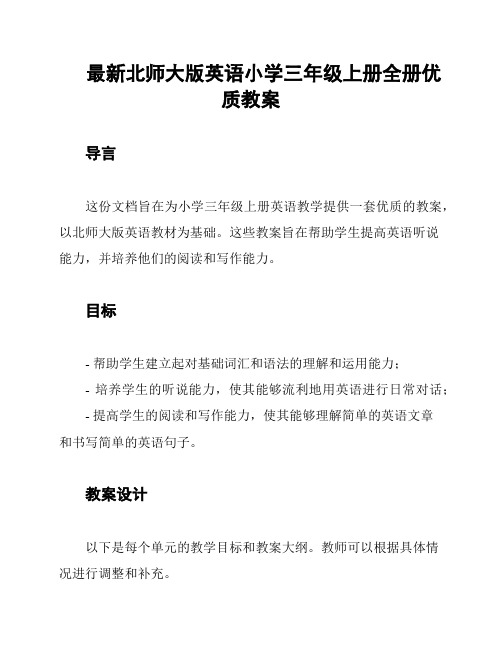
最新北师大版英语小学三年级上册全册优质教案导言这份文档旨在为小学三年级上册英语教学提供一套优质的教案,以北师大版英语教材为基础。
这些教案旨在帮助学生提高英语听说能力,并培养他们的阅读和写作能力。
目标- 帮助学生建立起对基础词汇和语法的理解和运用能力;- 培养学生的听说能力,使其能够流利地用英语进行日常对话;- 提高学生的阅读和写作能力,使其能够理解简单的英语文章和书写简单的英语句子。
教案设计以下是每个单元的教学目标和教案大纲。
教师可以根据具体情况进行调整和补充。
Unit 1: Hello!教学目标:- 研究问候语和自我介绍;- 研究数字 1-10;- 研究问与答“How are you?”。
教案大纲:1. 通过听唱歌曲 "Hello, Hello" 引入新课;2. 教授问候语和自我介绍的表达方式;3. 配对练,让学生进行问候和自我介绍;4. 研究数字 1-10,通过游戏和唱歌加深记忆;5. 研究问与答“How are you?”,进行角色扮演练。
Unit 2: Colors and Shapes教学目标:- 研究颜色和形状的基本词汇;- 研究描述物体颜色和形状的句子;- 研究问与答“Do you like...?”。
教案大纲:1. 通过展示彩虹和不同的颜色引入新课;2. 教授颜色和形状的基本词汇;3. 研究描述物体颜色和形状的句子;4. 进行颜色和形状的配对练;5. 研究问与答“Do you like...?”,进行小组问答练。
Unit 3: Family教学目标:- 研究家庭成员的称呼;- 研究介绍家庭成员的句子;- 研究包含家庭成员的对话。
教案大纲:1. 通过展示家庭照片引入新课;2. 教授家庭成员的称呼和介绍家庭成员的句子;3. 进行家庭成员的配对练;4. 研究包含家庭成员的对话,并进行角色扮演练;5. 进行小组讨论,谈论自己的家庭情况。
结束语以上是《最新北师大版英语小学三年级上册全册优质教案》的大体设计。
新北师大版小学二年级英语上册全册教案
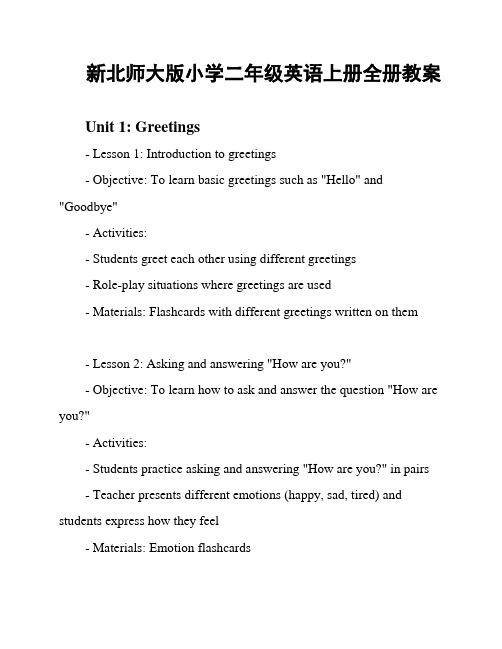
新北师大版小学二年级英语上册全册教案Unit 1: Greetings- Lesson 1: Introduction to greetings- Objective: To learn basic greetings such as "Hello" and "Goodbye"- Activities:- Students greet each other using different greetings- Role-play situations where greetings are used- Materials: Flashcards with different greetings written on them- Lesson 2: Asking and answering "How are you?"- Objective: To learn how to ask and answer the question "How are you?"- Activities:- Students practice asking and answering "How are you?" in pairs - Teacher presents different emotions (happy, sad, tired) and students express how they feel- Materials: Emotion flashcardsUnit 2: Numbers- Lesson 1: Introduction to numbers 1-10- Objective: To learn how to count from 1 to 10- Activities:- Students practice counting from 1 to 10 individually and as a class - Teacher presents objects and students count them- Materials: Counting flashcards- Lesson 2: Numbers 11-20- Objective: To learn numbers from 11 to 20- Activities:- Students practice counting from 11 to 20 using flashcards- Teacher presents random numbers and students say the corresponding number word- Materials: Number flashcardsUnit 3: Colors- Lesson 1: Introduction to colors- Objective: To learn basic colors in English- Activities:- Students learn color words through singing a color song- Teacher presents objects of different colors and students name the colors- Materials: Color flashcards, color song- Lesson 2: Mixing colors- Objective: To learn how to mix primary colors to create secondary colors- Activities:- Students mix primary colors using paint and create secondary colors- Teacher shows pictures of objects of different colors and students identify the colors used to create them- Materials: Primary color paints, pictures of objectsUnit 4: Animals- Lesson 1: Introduction to animals- Objective: To learn names of different animals in English- Activities:- Students learn animal names through a matching activity- Teacher presents flashcards with different animals and students name them- Materials: Animal flashcards, matching activity- Lesson 2: Animal sounds- Objective: To learn sounds made by different animals- Activities:- Students listen to audio recordings of animal sounds and guess the animal- Teacher presents pictures of animals and students imitate the sounds they make- Materials: Audio recordings of animal sounds, animal flashcards ... (continue with lessons for the remaining units)Assessment:- At the end of each unit, there will be a short assessment to test students' understanding of the content covered. The assessment may include multiple-choice questions, matching activities, and basic written exercises.Note for Teachers:- This lesson plan is designed for the textbook "新北师大版小学二年级英语上册."- Make sure to provide ample opportunities for students to practice speaking and listening skills.- Encourage students to participate actively and provide positive feedback to reinforce their learning.。
最新北师大版小学英语二年级上册教案(全册)
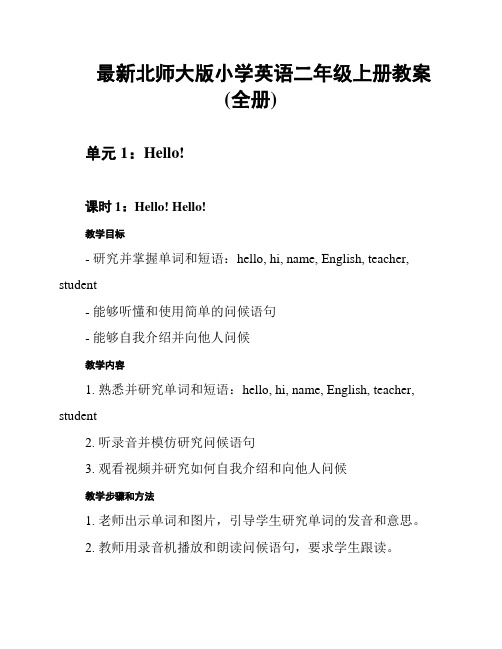
最新北师大版小学英语二年级上册教案(全册)单元1:Hello!课时1:Hello! Hello!教学目标- 研究并掌握单词和短语:hello, hi, name, English, teacher, student- 能够听懂和使用简单的问候语句- 能够自我介绍并向他人问候教学内容1. 熟悉并研究单词和短语:hello, hi, name, English, teacher, student2. 听录音并模仿研究问候语句3. 观看视频并研究如何自我介绍和向他人问候教学步骤和方法1. 老师出示单词和图片,引导学生研究单词的发音和意思。
2. 教师用录音机播放和朗读问候语句,要求学生跟读。
3. 教师播放视频,学生观看并模仿视频中的自我介绍和问候场景。
4. 学生进行小组活动,互相介绍和问候。
5. 教师进行课堂总结和点评。
家庭作业1. 背诵并模仿问候语句,与家人进行问候。
2. 观看家庭作业视频,向镜子自我介绍并问候。
单元2:My Family课时1:Family Members教学目标- 研究并掌握单词和短语:family, father, mother, sister, brother - 能够用英语介绍自己的家庭成员教学内容1. 研究单词和短语:family, father, mother, sister, brother2. 研究描述家庭成员的句子结构,如"Her name is Lisa. She is my sister."3. 观看视频,研究如何用英语介绍自己的家庭成员教学步骤和方法1. 教师出示图片和单词,引导学生研究单词发音和意思。
2. 教师示范用英语介绍家庭成员,要求学生跟读和模仿。
3. 教师播放视频,学生观看并研究如何用英语介绍家庭成员。
4. 学生进行小组活动,互相介绍自己的家庭成员。
5. 教师进行课堂总结和点评。
家庭作业1. 复单词和短语:family, father, mother, sister, brother2. 想一想如何用英语介绍自己的家庭成员,向家人进行练。
北师大版小学六年级英语上册(三年级起点)全册教案

Unit1 Space新课标体现:本单元主要是要求学生能够用过去时表达过去发生的一些事情,能够用本单元主要句式询问对方或他人在过去时间的住所。
让学生对一般过去时有一个初步的认识。
引导学生形成与人为善的态度。
本单元能够丰富学生的天文知识,激发学生乐于观察的热情。
Teaching Aims:知识技能:1、Listening:能够理解本单元的故事。
2、Speaking:能用过去时简单的描述在过去发生的事情,能用本单元主要句式询问对方或他人在过去时间的住所。
3、Reading:能正确、流利的朗读课文和一些辅音的读法。
4、Writing:能正确、规范地拼写本单元要求掌握的生词和短语;能听写本单元功能句,并做出应答。
过程方法:1、利用现有的教设备资源,使学生可以更加直观的对所要学习的内容有整体了解,并且可以培养学生良好的发音习惯,为以后的学习打下基础。
2、在教授对话的同时,把单词或重点句型出示给学生,这样可以使学生更方便于学习,掌握,和运用。
3、在教学时多采取同学之间互相帮助的功能,可以加深同学之间的感情,还可以帮助班主任更好的完成思想道德教育工作。
Teaching Emphasis:1.Where are you from? 及回答.2.Where were you yesterday afternoon? I was at home.3.过去时was, were, had 的表达Teaching Difficulty:1.过去时的用法及表达。
2.如何用过去时描述自己的梦和过去所在的场所。
3.一些单词的记忆。
Lesson1Teaching Aims:1. The students can describe the picture.2. The students like to learn English.3. The students can be writing and reading.Teaching Emphasis:1. How can use “had, was, were” in dialogue. Answer it.Teaching Difficulty1. How to use past tense.2. Emphasis new words.Teaching process:Step1:T: Introduce myself and let student introduce themselves (name, age, hobby and so on) S: Introduce themselves about name, age etc.Step2:To review what has been learned last semester.Step3:Set the sceneT: Let the children talk about what they did during the summer vacation. Ask some questions: Where you went? Who you saw? What you did?Let them share their experience with each other.S: Try to answer the questions.T: Ask the children the question, “Where were you?”S: Try to answer the question.Step4:Get preparedT: Ask children if they had any dream at night these days. Let them talk about their dreams.S: Try to talk about their dreamsT: let them read about Ann’s dream.S: Read Ann’s dream.T: To describe what illustrated in each picture and the main plot is.S: Listen and think.T: Play the tape for the story.S: Listen to the tape.Step5:Tell the storyT: Have the children look at the pictures .The teacher tells the story to the children.S: Listen and look at the picture.T: Have the children read the text by themselves.S: Read the text.T: Listen to the tape. Play the tape again. Ask some questions.Who had a dream?Who were in her dream?Where were they?Where were they now?Was it cold on Mars?Were there Martians on Mars? How do you think Ken and Ann fell?Were the Martians friendly?S: Try to answer the questions.Step6:Homework: Have the children create their own image of Martians.Blackboard writing:Ann had a dream last night.She and Ken were in her dream.They were in the space.They were on Mars.It was very cold on Mars.There were Martians on Mars. Ken and Ann were afraid.Yes, the Martians were friendly.课后反思:Lesson 2Teaching Aims:1. The students can describe the picture.2. The students like to learn English.3. The students can be writing and reading.Teaching Emphasis:1. How can use “had, was, were” in dialogue. Answer it.Teaching Difficulty1. How to use past tense.2. Emphasis new words.Teaching process:Step1:Review :( plays a game)T: Take a card and hide it. I had a dream last night. In my dream I was…S: Guess it.Step2:Learn the new words.T: Have the children open their books at page4. Draw their attention to the top half of the page. Point to the picture and ask: “What can you see in the picture?”S: Open the book and answer the question.T: Model the word and have the children repeat. Use the same procedure with the other words in the picture.S: Read the words after the teacher.T: Let student read the words again.S: read the words.T: Let students listen to the tape and point the new wordsS: listen and point. Repeat after the tape.Step3:Listen and number.T: Have the children look at the pictures at the bottom of the page. Explain that each of the pictures describes a different dream of Ann.S: Look at the picture.T: Let the children talk about where Ann was and what she was in each dream.S: Answer it.T: Play the tape. Let the children point the picture.S: Listen to the tape and point the picture.T: Play the tape again. Let children write the corresponding sentence number in the box next to the matching picture.S: listen and match.T: Point to each picture and elicit sentences from the children.Step4:Talk togetherT: Have the children open the books at page 5 and look at the picture on top of the page. S: Open the books look at the picture.T: Explain that Sue and Peter are talking about where they were yesterday. Ask the children where they think Sue and Peter were yesterday.S: Answer the question.T: Read the text and ask the children repeat.S: Listen and repeat.T: Pair works. For example, where was Ann yesterday? She was at the swimming pool. S: Practice the dialog.Step5:Listen and practice.T: Draw their attention to the picture at the bottom of the page. Have them talk about the picture and then practice reading the sentence by them.S: Talk about the picture.T: Play the tape and let student read after the tape.S: Listen and read.Step6:Homework: Read the story.Blackboard writing:Dream, Last night, air, afraid, yesterday, were, was, had, space, a spaceship, a space suit, an astronaut, a planet, the moon, stars.教学反思:Lesson3Teaching Aims:1. The students can tell the story.2. The students like to learn English.3. The students can be writing and speaking.Teaching Emphasis:1. How can use “had, was, were” to make sentences.Teaching Difficulty1. How to use past tense.2. How to tell the story..Teaching process:Step1:Review the story.T: Point to each picture, elicit the story from the children. Point to the first picture and say, “In this picture, Ann had a…” Elicit from the children Ann had a dream. Repeat with other pictures and highlight the sentences They were on Mars. They were in a spaceship. S: Follow the teacher and retell the story.T: Ask the questions, “Where were you yesterday?”S: I was at school. I was at home. I had an English class etc.T: write the sentences on the blackboard and let the children read each sentences.S: Read the sentences after the teacher.Step2:Uncle Booky’s BlackboardT: Tell the children to look at the blackboard on the top of page 6. Model the structures by reading them aloud to the class.S: Listen and think.T: Have the children repeat the structures in a class drill. Use all possible combinations. S: Repeat the structures.T: Explain that we use was/were to describe things that happened in the past. Give an example, He was in Shanghai yesterday. He is in Beijing now.S: Make the sentences by themselves.Step3:Touch and say.T: Let the children look at the pictures at the bottom of the page. Let them tell the Mocky’s dream and that they only to say one sentence for each picture.S: Try to tell the dream.T: Ask some questions, “Who were in Mocky’s dream? Where were they?S: Try to answer the questions.T: Point to the picture and elicit descriptions from the children.S: Try to describe the pictures.Step4:Read and write.T: Have the children open the books at page 7. Explain to the children that the letter was written by a girl called Jane. Have them complete the letter.S: Try to complete the letter.T: If the children cannot do it, discuss with your partner.S: Do it and discuss.T: Let the children read the letter together.S: Read the letter.T: Have the children write about Uncle Booky’s dream.S: Try to write it by them.Step5:Tell the dream.T: Have the children to tell each other their dreams like two children on the book. Put them into pairs and practice.S: Try to tell the dream about them.Step6:Homework: Tell the dream to their parents.Blackboard writing:I was at home. We were at home.I was at school. We were at school.I had an English class. We had an English class.课后反思:Lesson4Teaching Aims:1. The students can read the special sounds.2. The students like to learn English.3. The students can be listening and match.Teaching Emphasis:1. How to pronounce the special soundsTeaching Difficulty1. How to pronounce the special sounds.2. Listening and match and interview the students..Teaching process:Step1:Special sounds.T: Have the children look at the pictures and try to read the words.S: Look at the picture and try to read.T: Play the tape and have the children repeat.S: Listen and repeat.Step2:Decode the messageT: Have the children open the book and ask them if they can read the message.S: Look at the message.T: Have the children look at the code and ask the children to decipher the message by themselves.S: Decipher the message.Step3:Write the messageT: Have the children write the message to the Martians.S: Write the message.T: Have the children pair work (They give their message to each other and decode the message)S: Decode the message.Step4:Listen and match.T: Have the children look at the pictures on top of page9.S: Open the books.T: Have the children talk about the pictures.S: Talk about the pictures.T: Play the tape and have the children listen and match.S: Listen to the tape and match.T: Have the children tell the teacher the name of the children was in the pictures.Step5:Ask and find out.T: Have the children look at the pictures at the bottom of the page.S: Look at the picturesT: Have the children interview the other students for where they were yesterday.S: Interview and write the sentences on the book.When they finished have them report their findings.Homework:Write the message to the Martians.教学反思:Lesson5Teaching Aims:1. The students can read the story.2. The students like to learn English.3. The students can be listening and match.Teaching Emphasis:1. How to read the story and choose the right answerTeaching Difficulty1. How to read the story.2. How to answer the questions and write the wordsTeaching process:Step1:Read the story.T: Have the children open their books at page 10 and explain the new words.S: Read the new words.T: Have the children read the story by themselves.S: Read the story.T: Ask some questions about the story.S: Answer the questionsT: Play the tape and have the children listen carefully.S: Listen to the tape.Step2:Number the picture.T: Have the children look at the pictures and read the story again and number the pictures. S: Read the story and number.T: Have the children point to the pictures and find the sentences in the story.S: Point and find.T: Have the children read the story again and number the pictures.S: Read the story and number.Step3:Check the correct answer.T: Have the children read the story and find the correct answer.S: Read the story and do it.T: Have the children pair work.S: Pair work.Step4:Listen and write the words.T: Explain the words.S: Look at the form.T: Play the tape and have the children complete the story.S: Listen to the tape and do exercise.T: Correct the answer.Homework:Tell the story to the parents.教学反思:Lesson6Teaching Aims:1. The students can read the story.2. The students like to learn English.3. The students can be listening and match.Teaching Emphasis:1. How to read the story and choose the right answerTeaching Difficulty1. How to read the story.2. How to answer the questions and write the wordsTeaching process:Step1:Review the Ann’s dreamT: Have the children try to retell the Ann’s dream.S: Try to retell.T: Have the children retell the dream together.S: Do it.Step2:T: Have the children try to read Lane’s dream, and try to write the missing words. S: Read the Lane’s dream and tr y to write the missing words.T: Have the children try to read the dream and check the answer.S: Check the answer.Step3:T: Have the children write the Uncle Booky’s dream.S: Try to write it.T: Review Ann’s dream with children.S: Retell the dream.T: Have the children write three sentences about Ann’s dream.S: Try to do it.Step4:ReflectionT: Explain some sentences to the children.S: Open the books and look at the sentences.T: Have the children read the sentences and try to do it.S: Read the sentences and write the answer about this unit.T: Have the children do the group work.S: Group work and finish the reflection.Homework:Review Ann’s dream.Homework: Have the children write Ann’s dream.教学反思:Unit2 An Accident新课标体现:本单元主要是要求学生能够用过去时表达过去发生的一些事情,能够用本单元主要句式询问对方或他人在过去时间在干什么。
北师大版小学六年级英语上册教案5篇

北师大版小学六年级英语上册教案5篇北师大版小学六年级英语上册教案1教学目标:1. 能正确的听、说、读、写词汇holiday, last, early, meet, before能正确的听,说,读词汇 fun, National Day, a film, wonderful2. 能正确的听、说、句型What (else) did you do??We/I?3. 能正确地运用对话中的日常交际用语和三会句型 Did you like the film?It was a funny cartoon. We all liked it very much.. Were there any fruit trees on the farm? There were apple trees, orange trees and pear trees.4. 能正确地理解、掌握对话内容,并能朗读、初步表演对话。
5. 能运用本课所学语言谈论过去所做的事情。
教学重点:能正确地理解、掌握对话内容,并能朗读、初步表演对话。
教学难点:能比较流畅的朗读对话,并能在掌握对话的基础上运用本课所学语言谈论过去所做的事情。
课前准备:1.教具准备a.单词,句型卡片。
b.练习题纸。
(每人一张)c.设计并制作多媒体教学课件,准备多媒体教学的设施。
2.板书准备预先写好课题Unit 5 On the farm教学过程:Step 1 Greeting and warming-up1. T-Ss greet.(师生问好,活跃课堂,拉近师生距离)2. T: Look at this man, what’s his job?Ss: He is a farmer.T: His name is Macdonald. He has a beautiful farm.Before class, let’s listen to a song, it’s about Macdonald and his farm.Step 2 Presentation and practice1. Teach: National Day ,holiday, lastT: What day/date is it today?出示CAI指名回答 These seven days is this week.(CAI出示 this week) These seven days was last week.( CAI出示 last week)T: What date was it? 指名回答T: Yes. It was the first of October.And it was the National Day. (CAI出示National Day领读)When National Day comes ,we usually have a long holiday . I had a wonderful holiday.2 .T:Do you want to know what I did this National Day holiday?You can ask me what did you do?指名几个学生提问,可提醒学生看黑板上早已贴好的句子。
(整理)全英语北师大版小学英语四年级上册全册教案
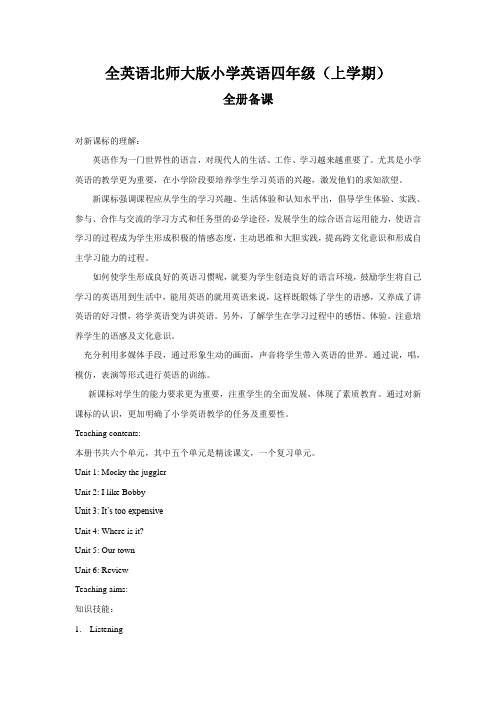
全英语北师大版小学英语四年级(上学期)全册备课对新课标的理解:英语作为一门世界性的语言,对现代人的生活、工作、学习越来越重要了。
尤其是小学英语的教学更为重要,在小学阶段要培养学生学习英语的兴趣,激发他们的求知欲望。
新课标强调课程应从学生的学习兴趣、生活体验和认知水平出,倡导学生体验、实践、参与、合作与交流的学习方式和任务型的必学途径,发展学生的综合语言运用能力,使语言学习的过程成为学生形成积极的情感态度,主动思维和大胆实践,提高跨文化意识和形成自主学习能力的过程。
如何使学生形成良好的英语习惯呢,就要为学生创造良好的语言环境,鼓励学生将自己学习的英语用到生活中,能用英语的就用英语来说,这样既锻炼了学生的语感,又养成了讲英语的好习惯,将学英语变为讲英语。
另外,了解学生在学习过程中的感悟、体验。
注意培养学生的语感及文化意识。
充分利用多媒体手段,通过形象生动的画面,声音将学生带入英语的世界。
通过说,唱,模仿,表演等形式进行英语的训练。
新课标对学生的能力要求更为重要,注重学生的全面发展,体现了素质教育。
通过对新课标的认识,更加明确了小学英语教学的任务及重要性。
Teaching contents:本册书共六个单元,其中五个单元是精读课文,一个复习单元。
Unit 1: Mocky the jugglerUnit 2: I like BobbyUnit 3: It’s too expensiveUnit 4: Where is it?Unit 5: Our townUnit 6: ReviewTeaching aims:知识技能:1.Listening充分利用现有的电教资源,如录音机、多媒体英语教学软件、自制课件等手段,让学生在一定的语言环境中学习英语,尽可能多地给学生一个英语母语的世界。
使学生能够听懂一些简单的基本的日常用语。
2.Speaking尽可能多地给学生提供说的机会,把自己所学的内容联系生活实际。
在实际的生活中讲英语,真正做到会讲英语。
北师大版小学一年级上册英语教案全册
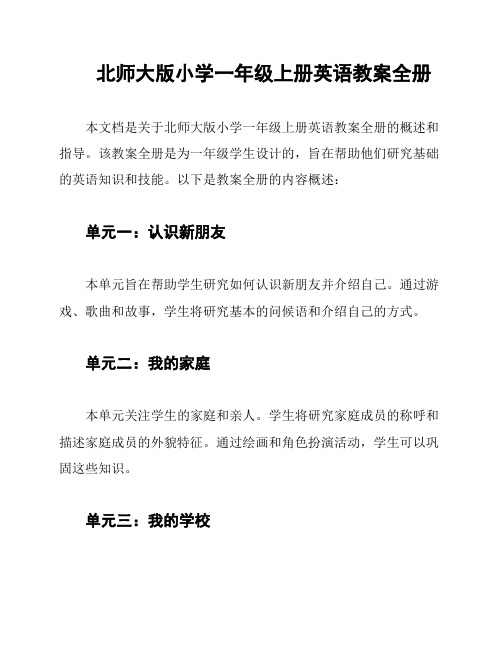
北师大版小学一年级上册英语教案全册
本文档是关于北师大版小学一年级上册英语教案全册的概述和指导。
该教案全册是为一年级学生设计的,旨在帮助他们研究基础的英语知识和技能。
以下是教案全册的内容概述:
单元一:认识新朋友
本单元旨在帮助学生研究如何认识新朋友并介绍自己。
通过游戏、歌曲和故事,学生将研究基本的问候语和介绍自己的方式。
单元二:我的家庭
本单元关注学生的家庭和亲人。
学生将研究家庭成员的称呼和描述家庭成员的外貌特征。
通过绘画和角色扮演活动,学生可以巩固这些知识。
单元三:我的学校
本单元旨在让学生了解他们的学校生活。
学生将研究关于学校的基本词汇,如教室、操场和图书馆。
通过游戏和讨论,学生可以分享他们在学校中的经历。
单元四:玩具和游戏
本单元关注学生的玩具和游戏。
学生将研究如何询问和回答有关玩具和游戏的问题。
通过角色扮演和小组活动,学生可以展示他们的玩具并与他人分享。
单元五:节日和庆祝活动
本单元介绍了一些重要的节日和庆祝活动,如生日和春节。
学生将研究相关的词汇和表达方式,并了解不同节日的传统和俗。
以上是北师大版小学一年级上册英语教案全册的概述。
教案通过丰富的教学活动和资源,旨在帮助学生建立起对英语的兴趣并提高他们的语言能力。
我们相信这套教案将为学生的英语学习提供有益的指导和支持。
北师大版(一起)小学英语一年级上册英语全册教案第一学期全套教学设计

Unit 1 Hello!(The first period)一、教学目的与要求1、能听懂并会说Hi/Hello, I’m×××. Hi/Hello,×××.2、并掌握单词:Uncle Booky, Ken, Ann, Mocky.3、用刚学过的句子学会自我介绍,要求模仿正确,语调自然。
4、听懂课堂用语Stand up, please. Sit down, please, 并作出相应的动作。
二、教学重点:学会句型Hi, I’m ×××. Hello,×××.三、教学难点:学习用句子Hi, I’m ×××.Hello,×××.进行自我介绍和打招呼。
四:教学过程1、组织教学教师面带笑容走进教室,先作自我介绍,用英语说I’m ×××(教师自己的名字)然后用中文说我是×××。
接着再说一遍英文。
教师再说,从今天起我给你们上英语课,我们大家一起学。
2、学习课堂用语Stand up, please. Sit down, please。
教师说Stand up, please. 然后伸出双手,掌心向上摆动,示意学生起立。
教师再说Sit down, please. 掌心向下摆动,示意学生坐下。
教师走到学生当中,边说边示意。
全班学生做,小组做,最后抽查个别学生做。
接着,教师又站回讲台前,再慢速而准确地说一遍,让学生注意教师发音的口型。
3、学习单词Uncle学习用句型Hi, I’m ×××. Hello,×××.进行对话。
(1)教师在讲台前作示范,带表情和手势。
要求学生注意看教师发音的口型和表情。
(2)教师再说I’m ×××(教师自己的名字)。
北师大版一年级上册《英语》全册教案

北师大版一年级上册《英语》全册教案第一单元:Hello, I'm ...教学目标1. 能够听懂并正确回答“Hello, I'm ...”的问候。
2. 能够听懂并正确表达自己的名字。
3. 能够听懂并正确表达“How old are you?”的询问。
4. 能够听懂并正确回答自己的年龄。
教学内容1. 单词:hello, I'm, name, how old, five, year, old2. 句型:Hello, I'm ... / How old are you? I'm ... years old.教学步骤1. 热身活动:唱英文歌曲《Hello, Hello, Hello!》2. 引入新课:展示图片,引导学生说出自己的名字和年龄3. 讲解新单词和句型,让学生进行模仿和练习4. 小组活动:让学生相互问候并介绍自己5. 课堂小结:回顾本节课所学内容,进行总结作业布置1. 抄写单词和句型2. 家长签字确认第二单元:Good morning教学目标1. 能够听懂并正确使用“Good morning”进行问候。
2. 能够听懂并正确表达“Good afternoon”和“Good evening”。
3. 能够听懂并正确回答“What's your name?”的询问。
4. 能够听懂并正确表达自己的名字。
教学内容1. 单词:good morning, good afternoon, good evening, name2. 句型:What's your name? My name is ...教学步骤1. 热身活动:唱英文歌曲《Good Morning》2. 引入新课:展示图片,引导学生说出正确的问候语3. 讲解新单词和句型,让学生进行模仿和练习4. 小组活动:让学生相互问候并介绍自己5. 课堂小结:回顾本节课所学内容,进行总结作业布置1. 抄写单词和句型2. 家长签字确认第三单元:Goodbye, see you tomorrow教学目标1. 能够听懂并正确使用“Goodbye”进行道别。
新北师大版四年级英语上册全册教案教学设计
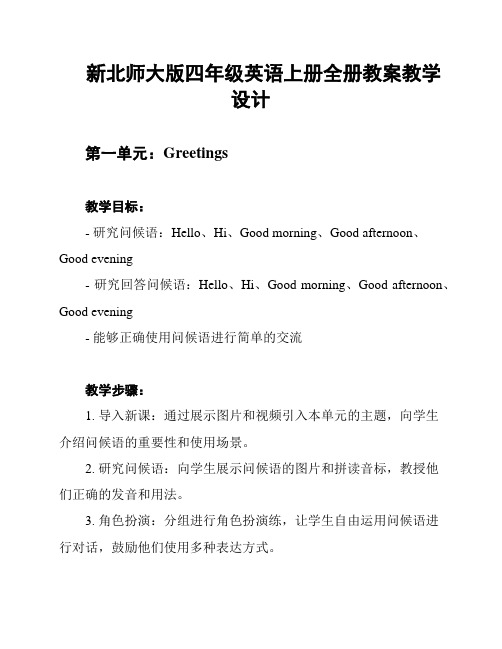
新北师大版四年级英语上册全册教案教学
设计
第一单元:Greetings
教学目标:
- 研究问候语:Hello、Hi、Good morning、Good afternoon、Good evening
- 研究回答问候语:Hello、Hi、Good morning、Good afternoon、Good evening
- 能够正确使用问候语进行简单的交流
教学步骤:
1. 导入新课:通过展示图片和视频引入本单元的主题,向学生
介绍问候语的重要性和使用场景。
2. 研究问候语:向学生展示问候语的图片和拼读音标,教授他
们正确的发音和用法。
3. 角色扮演:分组进行角色扮演练,让学生自由运用问候语进
行对话,鼓励他们使用多种表达方式。
4. 游戏活动:设计问候语游戏,让学生通过游戏练灵活运用问候语,增强记忆和理解。
5. 总结与拓展:通过小组讨论,总结本课程所学的问候语,并让学生在日常生活中应用和实践。
教学资源:
- 图片和视频素材:问候语的相关图片和视频
- 角色扮演卡片:包含不同问候语的卡片
- 游戏活动素材:问候语游戏卡片和道具
- 小组讨论记录表:用于记录学生在讨论中的发言和总结
教学评估:
- 角色扮演表现评估:观察学生在角色扮演活动中是否正确运用了问候语,并评估他们的口语表达能力。
- 游戏活动积分评估:根据学生在问候语游戏中的表现,进行积分评估,鼓励他们积极参与和竞争。
- 小组讨论记录评估:根据学生在小组讨论中的发言和总结情况,评估他们的思维能力和合作意识。
